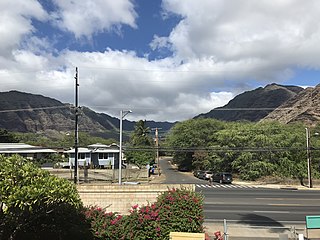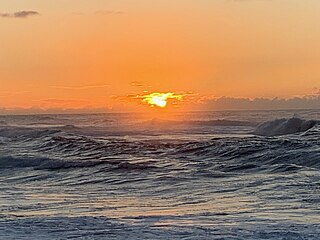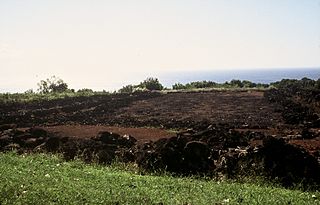
Mākaha is a census-designated place (CDP) in Honolulu County, Hawaiʻi, United States. It is a town located along the Pacific coast, west of the Mākaha Valley, and at the foot of Mt. Ka'ala in the Wai’anae Mountain Range. It is the last of the leeward towns on O'ahu. North of Mākaha there is no development, i.e. no towns, no gas stations, or restaurants. The population of Mākaha was 8,278 at the 2010 census. It is located 35 miles northwest of Honolulu, but is a part of Honolulu County.

Robert Kelly Slater is an American professional surfer, best known for being crowned World Surf League champion a record 11 times. Slater is widely regarded as the greatest professional surfer of all time, and holds 56 Championship Tour victories. He won the Laureus World Action Sportsperson of the Year four-times. Slater is also the oldest surfer still active on the World Surf League, winning his 8th Billabong Pipeline Masters title at age 49.

Big wave surfing is a discipline within surfing in which experienced surfers paddle into, or are towed into, waves which are at least 20 feet high, on surf boards known as "guns" or towboards. Sizes of the board needed to successfully surf these waves vary by the size of the wave as well as the technique the surfer uses to reach the wave. A larger, longer board allows a rider to paddle fast enough to catch the wave and has the advantage of being more stable, but it also limits maneuverability and surfing speed.

Edward Ryan Makuahanai Aikau was a Hawaiian lifeguard and surfer. As the first lifeguard at Waimea Bay on the island of Oahu, he saved over 500 people and became famous for surfing the big Hawaiian surf, winning several awards including the 1977 Duke Kahanamoku Invitational Surfing Championship. The Eddie Aikau Big Wave Invitational is named in his honor. He was also a crew member on the Polynesian voyaging canoe Hōkūleʻa.
Mark Sheldon Foo was a professional surfer who favored big wave surfing. Foo drowned while surfing at Mavericks, Half Moon Bay, California, in 1994.

The Banzai Pipeline, or simply Pipeline or Pipe, is a surf reef break located in Hawaii, off Ehukai Beach Park in Pupukea on O'ahu's North Shore. A reef break is an area in the ocean where waves start to break once they reach the shallows of a reef. Pipeline is known for huge waves that break in shallow water just above a sharp and cavernous reef, forming large, hollow, thick curls of water that surfers can tube ride. There are three reefs at Pipeline in progressively deeper water farther out to sea that activate according to the increasing size of approaching ocean swells.
Patrick Shane Dorian, or "Shane", is an American surfer from Kailua-Kona, Hawaii. He spent 11 years touring on the World Championship Tour as a professional surfer. Dorian quit competition surfing in 2003 to focus on big waves. He is currently a big wave surfer and one of the best in the world at big wave riding.
Ross Clarke-Jones is an Australian big wave surfer. He originally came from Terrigal in the Central Coast, of New South Wales, Australia where he enjoyed surfing Terrigal Haven, a point break that produces rare waves lasting for up to 300 metres on a big swell.
Bruce Irons is an American regularfoot professional surfer from Hanalei, Kauai, and is often regarded as one of the best tuberiders of all time. He is the younger brother of three-time world champion Andy Irons.

Sunset Beach is on the North Shore of Oahu in Hawaii and known for big wave surfing during the winter season. The original Hawaiian name for this place is Paumalū. It is a two-mile stretch of mostly beige sand located at 59-104 Kamehameha Highway in Pupukea, 39 miles driving distance from Waikiki. Lifeguards are usually present.

Puʻu o Mahuka Heiau State Historic Site on the North Shore of Oʻahu is the largest heiau (temple) on the island, covering 2 acres (8,100 m2) on a hilltop overlooking Waimea Bay and Waimea Valley. From its commanding heights, sentries could once monitor much of the northern shoreline of Oʻahu, and even spot signal fires from the Wailua Complex of Heiaus on Kauaʻi, with which it had ties. It was designated a National Historic Landmark in 1962, when it became the center of a 4-acre (16,000 m2) state park. It was added to the National Register of Historic Places in 1966.

Waimea Valley is an area of historic cultural significance on the North Shore of Oahu, Hawaii. The valley, being an important place in Hawaiian religion, includes several historical structures including stone terraces and walls constructed during the time of the Hawaiian monarchy. The nutrient-rich volcanic soil combined with a rainy environment provided the resourceful Hawaiians of the area the opportunity to create one of the most prosperous farming communities in all of Polynesia. The area had complex fish ponds, domesticated animal pens, various large farming beds, and was famous for the cultivation of pink taro root stock, a coveted item to the Ali`i. Much of the garden floor was once cultivated for taro, sweet potato, and bananas, with new crops and orchards introduced by Europeans after their arrival.
The Eddie Aikau Big Wave Invitational is a big wave surfing tournament held at Waimea Bay on the north shore of Oahu, Hawaii. The tournament is named for native Hawaiian, champion big wave surfer, and life-saving Waimea Bay lifeguard, Eddie Aikau. Created in 1984 at nearby Sunset Beach, the invitational tournament moved to the notoriously big-waved Waimea Bay, where Aikau's family maintains an ancestral tradition as caretakers of Waimea Valley.
The Duke Kahanamoku Invitational Surfing Championship is named in honor of the "Father of Modern Surfing", Duke Paoa Kahinu Mokoe Hulikohola Kahanamoku. The contest began in 1965 by invitation only at Sunset Beach on the North Shore of Oʻahu until it was replaced by the Billabong Pro in 1985. The championship was the first surfing event to be broadcast on a regular basis by ABC's Wide World of Sports.

Greg Long is an American surfer from San Clemente, California. He has won the Quiksilver Big Wave Invitational, in memory of Eddie Aikau at Waimea Bay, the Red Bull Titans of Mavericks event held at Mavericks in Northern California, and the Red Bull Big Wave Africa event held at Dungeons in Hout Bay, South Africa. Additionally, he is the most decorated surfer in the Billabong XXL Global Big Wave Awards. He is widely regarded as one of the best big wave surfers in the world.
Darrick Doerner is a big wave pioneer in the sport of tow-in surfing, in which personal water craft are used to tow surfers into large surf. Also known by the nickname, Double D, Doerner is an accomplished big wave surfer himself.

The North Shore, in the context of geography of the Island of Oʻahu, refers to the north-facing coastal area of Oʻahu between Kaʻena Point and Kahuku. The largest settlement is Haleʻiwa.
Gary Elkerton, known as Kong is an Australian surfer, three time world masters champion, three time world professional runner-up, twice Hawaiian Triple Crown champion and Australian amateur champion (1984). He is regarded as an iconic big-wave rider and is highly respected by his peers for his unique, powerful surfing style. In 2009, Gary was inducted into the Australian Surfing Hall of Fame.
Chris Christenson is an American surfboard shaper, craftsman, and outdoor enthusiast.

Surfing in the United States is a popular hobby in coastal areas, and more recently due to the invention of wave pools, inland regions of the country. It contributes to a lifestyle and culture in which millions participate and which millions more have an interest. USA surfing is the governing body for the sport of surfing in the United States, with surf leagues such as the World Surf League available in the country. Surfing can be traced back to 17th Century Hawaii and has evolved over time into the professional sport it is today, with surfing being included for the first time in the 2020 Summer Olympics in Tokyo.













